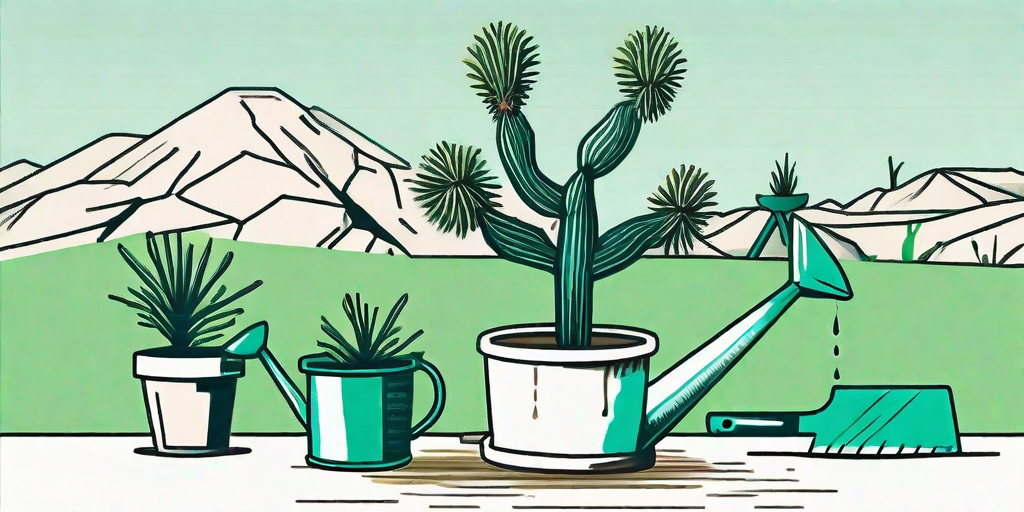
Welcome to the world of plant parenthood! If you're reading this, you're probably considering adopting a Joshua Tree (Yucca Brevifolia) into your family of houseplants. Or perhaps you've already taken the plunge and are now frantically googling "how to care for a Joshua Tree". Either way, you're in the right place. This guide will transform you from a nervous newbie to a confident Joshua Tree parent in no time.
Understanding Your Joshua Tree
Before we dive into the nitty-gritty of Joshua Tree care, let's get to know our green friend a little better. The Joshua Tree, native to the arid southwestern United States, is a type of yucca plant. This hardy desert dweller can live for hundreds of years and grow up to 40 feet tall. It's a slow grower, though, so don't worry about it outgrowing your living room anytime soon.
Joshua Trees have a unique, almost otherworldly appearance. Their spiky leaves and twisted, bristly branches give them a distinctive silhouette that's sure to make a statement in your home. But don't be fooled by their tough exterior; Joshua Trees have a sensitive side too. They require just the right balance of light, water, and temperature to thrive.
The Importance of Light
As desert plants, Joshua Trees love the sun. They need plenty of bright, indirect light to grow strong and healthy. A south or west-facing window is an ideal spot for your Joshua Tree. But be careful not to expose it to direct sunlight for too long, as this can scorch its leaves.
If you don't have a suitable window, don't despair. Joshua Trees can also grow under fluorescent lights. Just make sure to keep the lights on for about 14 hours a day to mimic the long daylight hours of their native habitat.
Watering Wisdom
When it comes to watering your Joshua Tree, less is more. These plants are adapted to survive in dry conditions, so they don't need much water. Overwatering is a common mistake among new Joshua Tree parents and can lead to root rot, which is often fatal.
So how often should you water your Joshua Tree? A good rule of thumb is to wait until the top inch of soil is dry before watering. In the cooler months, you may only need to water your plant once a month. In the warmer months, you might need to water it once a week. But remember, every plant is unique, so pay attention to your Joshua Tree's needs and adjust your watering schedule accordingly.
Growing Joshua Trees from Seed
Now that we've covered the basics of Joshua Tree care, let's move on to the exciting part: growing your own Joshua Tree from seed! This is a rewarding process that requires patience and a bit of green thumb magic. But don't worry, we'll guide you through every step of the way.
First, you'll need to get your hands on some Joshua Tree seeds. These can be purchased online or harvested from a mature Joshua Tree. If you're harvesting your own seeds, make sure to do so responsibly and with permission.
Step 1: Preparing the Seeds
Joshua Tree seeds have a tough outer shell that needs to be softened before they can germinate. This process, known as scarification, involves soaking the seeds in warm water for 24 hours. After soaking, the seeds should be ready to plant.
If you're not ready to plant your seeds right away, you can store them in a cool, dry place for up to a year. Just make sure to keep them away from moisture and heat, as these can damage the seeds and reduce their viability.
Step 2: Planting the Seeds
Once your seeds are prepared, it's time to plant them. Fill a pot with a well-draining soil mix, such as a cactus or succulent mix. Place the seeds on top of the soil and lightly cover them with more soil. The seeds should be about 1/4 inch deep.
After planting, water the soil thoroughly and place the pot in a warm, sunny spot. Keep the soil moist but not soggy, and be patient. Joshua Tree seeds can take anywhere from a few weeks to a few months to germinate.
Frequently Asked Questions
How long does it take for a Joshua Tree to grow?
Joshua Trees are slow growers. It can take several years for a seedling to reach a noticeable size, and a mature Joshua Tree can take decades to reach its full height. But don't let this discourage you. Watching your Joshua Tree grow and change over the years is part of the joy of plant parenthood.
Can I grow a Joshua Tree indoors?
Absolutely! Joshua Trees make excellent houseplants. They're tolerant of dry indoor air and can adapt to a variety of light conditions. Just make sure to provide them with plenty of bright, indirect light and avoid overwatering.
Do Joshua Trees need a lot of water?
No, Joshua Trees are adapted to survive in dry conditions and don't need much water. Overwatering can lead to root rot, which is often fatal. Wait until the top inch of soil is dry before watering your Joshua Tree.
Conclusion
And there you have it, a comprehensive guide to growing Joshua Trees from seed. With a bit of patience, the right care, and a dash of plant parent love, you'll be well on your way to raising a healthy, happy Joshua Tree. So go forth, embrace your new role as a plant parent, and remember: the journey is just as important as the destination. Happy planting!















